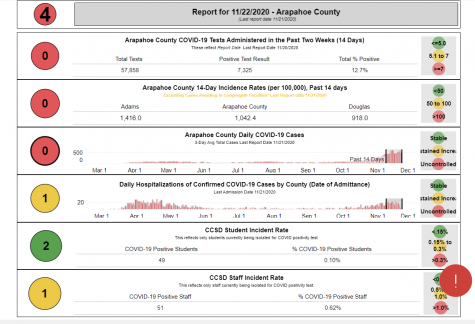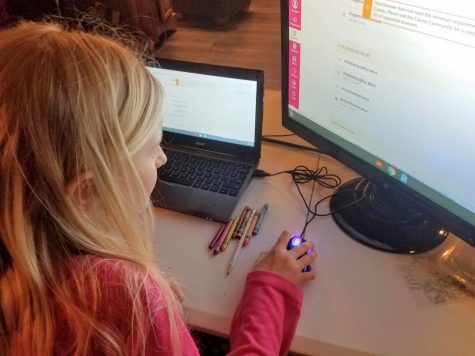A Tumultuous Transition
The switch to remote learning brings challenges but promotes community.
We are at the start of a new era of education. Perhaps it will only last the next few weeks, or perhaps it will become our new reality. Either way, remote learning is here to stay for the moment. This new way of learning is a product of 2020- a year the world has come to know as somewhat of a disaster. A disaster that has had a great effect on public education, even now, seven months later.
In response to rising cases among the community, the Cherry Creek School District announced their plans to switch to full remote learning on Friday, November 6th. The district used their COVID Tracker, which pulls from the Tri-County Health data, to rate six different data points for Arapahoe County -things like the Arapahoe County COVID-19 Positivity Rate and CCSD Student and Staff Incident Rates- to determine how safe it was to stay in school.

“Due to a lack of guidance on how decisions should be made regarding In-Person vs Remote learning, Dr. Siegfried designed this system to ensure that critical decisions about opening schools are grounded in data about COVID infections and trends,” said the district on their new, Forward Together site.
The district emphasized the scientific basis of their metrics, noting that they are meant to be unbiased and not based on politics or the actions of other districts. Instead, these ratings were meant solely to establish the relative safety of the district and help determine whether In-Person learning was still viable. And near the end of October, a sustained change in these numbers prompted the district to move learning to a full remote setting.
“Going remote isn’t just the best decision right now; it’s the only decision,” said english teacher Josh Steiner. “It’s the one thing that we can do as a district to keep kids safe. If they aren’t in the building, that variable of physical interaction is greatly lessened.” And it wasn’t just the teachers who agreed with this.
“I think it was a pretty good idea to put us online,” said junior Ellie Hull. “I don’t know if it will lower case numbers because you can’t really control where people go when they aren’t in school.” But it will halt the spread in schools, which will hopefully help the overall case numbers as well. And though perhaps not everyone was as completely on-board as Steiner and Hull, many did agree that it seemed to be the best decision.
“As a teacher, I would strongly prefer that students and teachers stay in school if it is safe to be in school, but we cannot ignore the impact of COVID-19 in our community,” math teacher Galen Collins said -a statement that undoubtedly resonates with so much of the community right now. As cases in Colorado rise, almost everyone now knows someone with COVID.
“Right now, it’s rather shocking, but about one in every 49 Coloradans is contagious with this,” Colorado Governor Jared Polis said in a remote update on November 20th. And so the same rise in cases that prompted CCSD to go remote is also eliciting new restrictions on a state level. But physical health is, of course, not the only thing at stake right now.
“Like most teachers, I have serious worries about student engagement, motivation, and their emotional well-being,” said Steiner. Online forums are inarguably different than an in-person learning environment, and for many, online learning is much less conducive to academic participation and motivation. It can be difficult to stare at a screen for hours at a time, seeing friends virtually but not being able to interact in the same way that one would in a classroom. Collins agreed, elaborating on some of the worries teachers have.
“I worry about the mental and emotional well-being of students who might be socially isolated through all of this. I worry that not all students have the same access to technology and the resources they need to be successful at home. I worry about feeling like I cannot connect with my students as well if we are not together in person,” she said, urging our community to not forget the mental health of students and staff.
Certainly, all the physical restrictions -wearing masks, social isolation, fewer places to go- are taxing, but mental health is becoming ever more critical as an increasing number of students and staff are stuck at home without the same level of interaction and connection. So although the decision to go remote seems like the right one, it comes with it’s own challenges, and as a community, finding a way to work in this new environment has become increasingly crucial.
“Giving grace and leeway to students will be the best way to reduce the anxiety that we feel with tons of deadlines and the overwhelm of everything,” said sophomore Katelyn Aasman. “I think teachers are doing a pretty good job with offering help and grace so the next step is to just for everyone to get comfortable with the new expectations.” And although there are certainly new expectations we have to get used to, it can be helpful to still maintain some level of familiarity and routine. In fact, many of the resources we had while in-person at school are still available remotely.
“Like in a regular school year, it is hard to catch up if you let yourself fall too far behind,” Collins said. “Reach out to your teachers if you need help getting caught up in a class. We want you to be successful.” The switch to remote learning, as students and staff both acknowledged, was not going to be easy. But Steiner urges students to not give up.
“Don’t quit. Don’t shut down. Don’t be a pessimist. We’re all in this together, and we’re all doing the best we can. Just take things one day at a time, keep fighting, and know that the sun will come up tomorrow,” said Steiner. And just as teachers like Steiner are supporting students in this time, Hull advocates that students support the teachers as well.
“Be patient with your teachers, they are learning just as much as we are in this new situation,” Hull said. But as much as patience plays a part in the success of remote learning, so too do study habits.
“My new advice is to focus on wise time management outside of your synchronous classes. For me, I like to take breaks after school so I have to set rules for when to complete the rest of my assignments,” said Aasman. Participation, asking questions, connecting with peers and teachers for help: these are all going to become even more important in such a time of decreased in-person interaction. Collins, meanwhile, is taking this change as an opportunity to expand her own talents.
“I’m excited about this opportunity to re-think instruction,” Collins said. “I hope to try some new tools for formative assessment and instruction. I think teachers are engaging in conversations about ‘What are the most important things for students to learn?’ and that is important for us to think about.” Her optimism is something that has been rather missing for many students and staff in the switch to remote learning thus far. Instead of viewing the change as a hindrance, a setback, and an obstacle, Ms. Collins chooses to see it as an opportunity for growth. And although the benefits of remote learning haven’t been mentioned nearly as much as the drawbacks, there are, in fact, some positives.
“The biggest benefit is that we’re back to a somewhat normal A/B schedule, that we can interact more than once a week, and that we’re all staying safer at home,” said Steiner, though he also acknowledges its difficulties.
“The biggest drawback is not being able to teach in person, and students not having their cameras on. Teaching to a wall of names is pretty awful,” he said. “It’s really difficult, it’s hard to find a rhythm, but I know I’ll find a way to adapt. I’ll push through and do my best.” After over half a year living through a pandemic, with circumstances constantly changing, it can be truly difficult to remain positive and to adapt. And our community seems to be feeling it -and not just the staff. Students, like Aasman, are struggling as well.
“I’m not excited to continue remote learning for possibly more than a couple of weeks,” said Aasman, echoing the sentiments of so many. She noted the difficulty of managing a multitude of new learning platforms and balancing support labs and asynchronous work on top of synchronous learning, touching on the difficulty of adjusting to a completely new learning style.

“I think with time, both students and staff will adapt and remote will be more effective,” Aasman said. “But as of right now, I assume it’s hard for teachers to plan and navigate remote, and it’s hard for students to not only manage time and assignments but also now manage all the classes and their different expectations.”
“Remember that this is a time in our lives that will pass,” said Collins. “I don’t know how long it will take, but I believe things will get better. Take care of yourself first and try to find things to be joyful about.” And while it’s true that we cannot predict when remote learning -or even the pandemic itself- will be over, it’s also true, according to Collins, to make something good of a perhaps otherwise challenging time.
Whether it’s getting excited about a new way to teach or learn, the benefit of being safer at home, or simply getting to know the other half of your classes, there is a potential for positivity. In such a time of change and turmoil, our community, despite the distance between us, may also be our strongest asset.

Simone Beauchamp is a Senior at Eaglecrest and, as she will let you know, she graduated from Challenge Middle School. She has many talents - photography,...





